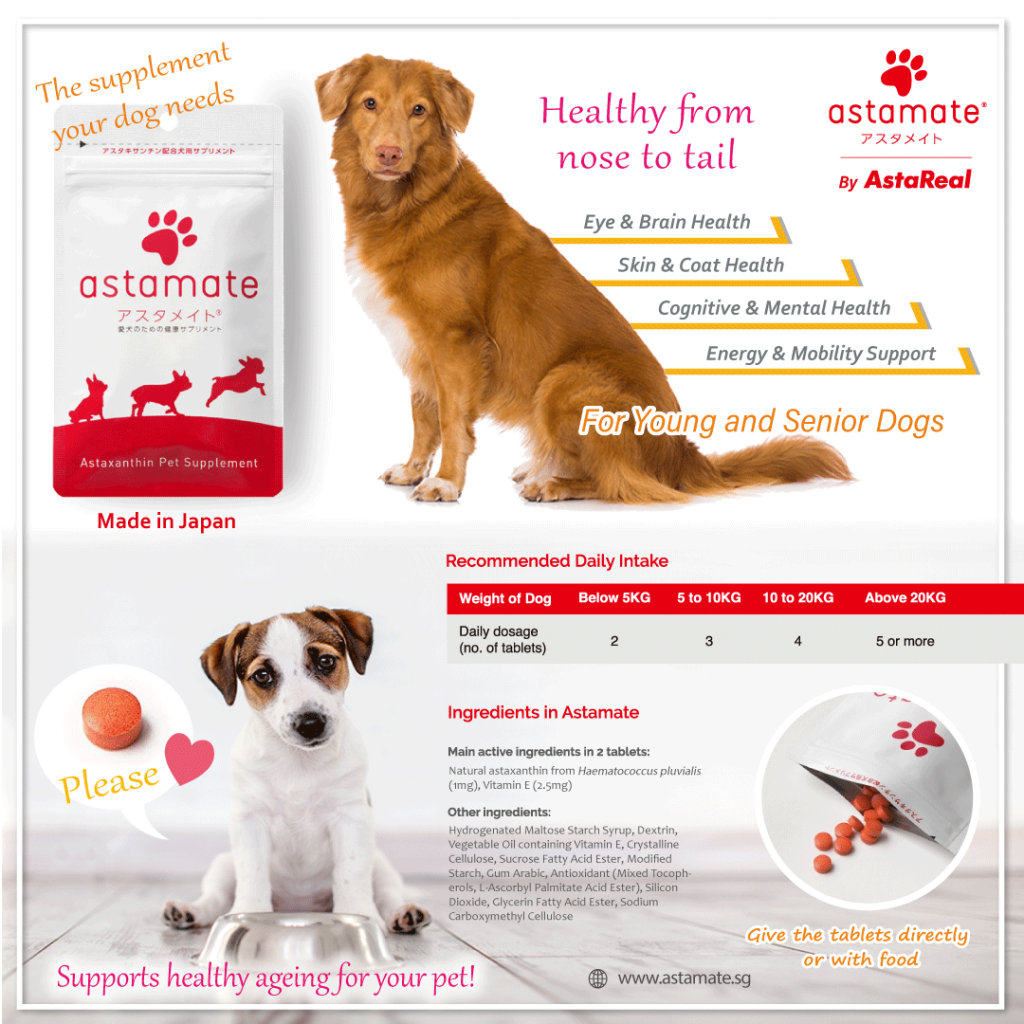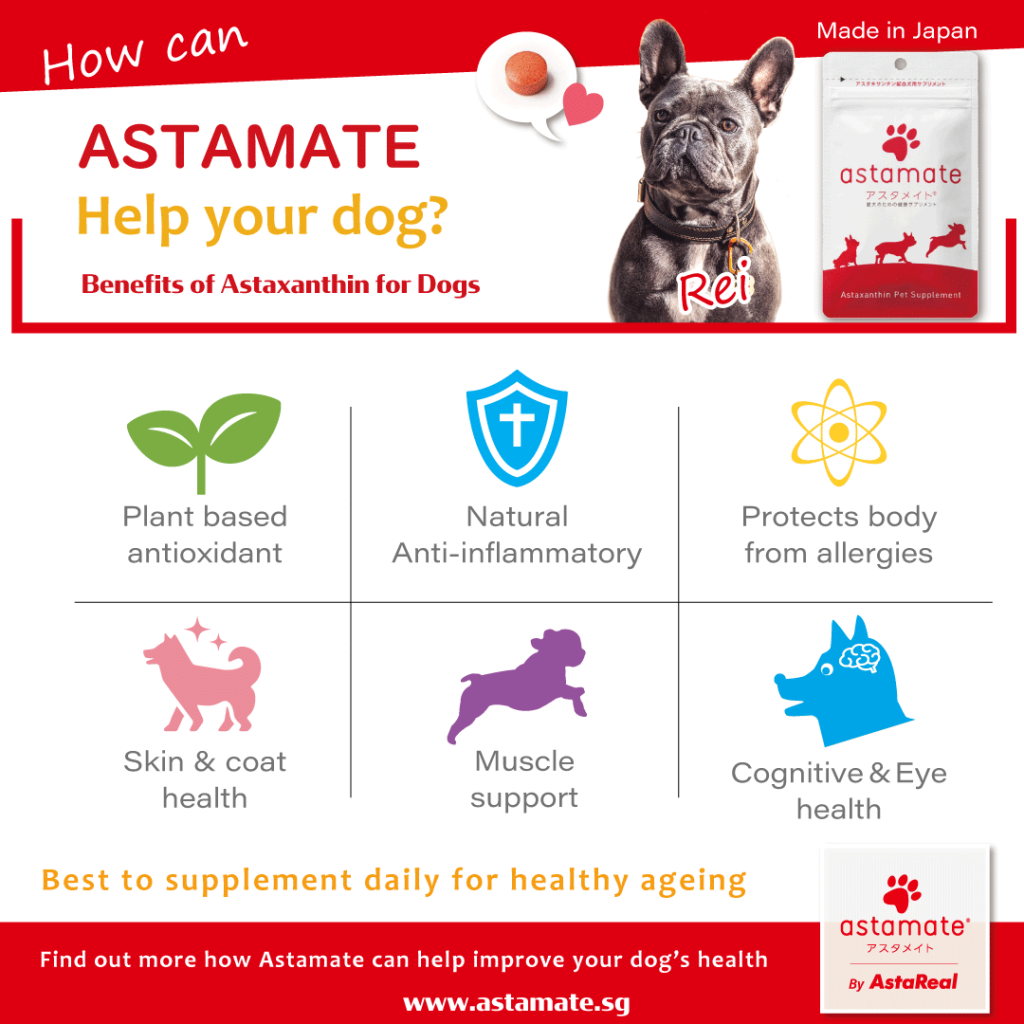Introduction:
When it comes to supporting our furry friends’ overall health and well-being, exploring natural supplements is a worthwhile endeavour. One such supplement that has gained significant attention in the last 30 years is astaxanthin. Though commonly associated with its benefits for humans (Bjørklund G., et al., 2022), astaxanthin also offers the same range of potential advantages for dogs (and cats). In this article, we will delve into the world of astaxanthin and discover how it can positively impact your pets’ health.


Haematococcus pluvialis microalgae isolated from the Swedish archipelago is cultivated for natural astaxanthin and then harvested after the algal cells mature. Astaxanthin is a naturally occurring compound known as a carotenoid and a cousin of lycopene or beta-carotene. Astaxanthin is a plant-based antioxidant that is prevalent in marine life and some land animals. Astaxanthin is renowned for its potent antioxidant and anti-inflammatory properties. For example, salmon store astaxanthin obtained from their food and pass on to its roe (ikura) which it protects against from sunlight damage in the river. Furthermore, astaxanthin incorporates into the muscles giving the vibrant reddish coloration seen in wild sockeye salmon giving them extreme endurance. For your dog, supplementation is recommended because it is generally more economical and practical than trying to feed wild sockeye salmon every day. Therefore, Astamate is an ideal candidate to manage daily oxidative stress and promoting long-term well-being in pets.
Enhanced Joint Health:
Astaxanthin’s non-steroidal anti-inflammatory properties may help reduce joint inflammation and maintain muscle health, offering support for dogs with arthritis and hip dysplasia. Even after low intensity exercise, muscle damage can increase 2 to 5 fives in unconditioned dogs. Fortunately, this can be treated with astaxanthin to improve QOL and faster recovery (Huntingford J. L. 2014; Aoi et al., 2003). By promoting improved mobility, it enables your canine companion to move with greater ease and comfort.
Improved Skin and Coat Health:
Astaxanthin’s antioxidant properties contribute to healthier skin and coat in dogs. By combating free radicals and reducing oxidative stress, it can result in a shinier and more vibrant coat, reduced dryness, and improved skin elasticity for your furry friend. In one case report, Furuya et al., 2015 reported dogs treated for Cushing’s Disease. 2 mg daily or four Astamate tablets in conjunction with usual drug therapy improved the coat dramatically compared to non-treated group after six weeks treatment.
Enhanced Immune System Function:
With its potent antioxidant properties, astaxanthin can help bolster your dog’s and cat’s immune system. Studies by Chew B. P. et al. (2011) and Park J. S. et al. (2011), showed 6mg daily for 12 weeks and 1mg for 12 weeks can boost the cell-mediated (more effective macrophages) and humoral responses (better antigen response) in dogs and cats respectively. By protecting against harmful pathogens and promoting overall immune function, it supports their ability to fight off infections and stay healthy.
Eye and Vision Support:
Maintaining good eye health is crucial for dogs of all ages. Astaxanthin has shown potential in supporting ocular health by protecting the cornea, lens and retina against premature oxidative damage and maintain healthy looking eyes and optimal vision. Several species of birds like crows and seagulls naturally store astaxanthin in their eyes to protect their vision probably because of intense UV radiation from the sun. In a controlled study of 6–8-year-old healthy beagles, a multi-carotenoid-vitamin formulation of 5mg astaxanthin daily showed that it can increase retinal function and decrease the refractive error change after a six-month study. In the untreated group, the vision declined. Therefore, antioxidant supplementation may be beneficial and effective in the long-term preservation and improvement of retinal function and the slowing of refractive error changes associated with ageing in dogs (Wang et al., 2016).
Mitochondrial Health:
The mitochondria are sub-cellular engines that create ATP energy for all movement and biological processes in the body. It can also communicate to other cells its condition. It is also prone to oxidation because of the high metabolic activity and can result in less-than-optimal energy production and turn into a condition known as mitochondrial dysfunction which is closely tied to vicious cycle of inflammation and disease progression. Furthermore, as your dog ages, the number mitochondria declines. Astaxanthin protects and regulates mitochondria and even reported to increase the production of new mitochondria (Nishida, Y. et al., 2021). Park J. S. et al. (2010) showed that supplementation in dogs needed 16 days at 2.5mg/day to reach mitochondria. For cats, it took 6 days at 0.4mg/day. Maintaining healthy mitochondria with astaxanthin is an idea way to keep your furkid’s body working in tip top condition and reduce the risks of serious health complications and long-term health (Park J. S. et al., 2012).
Brain Health:
Just like humans, ageing affects the brain and memory in dogs and cats (Vitae & Head 2014). In recent research, astaxanthin has also been linked to potential benefits for canine brain health. Its antioxidant and anti-inflammatory properties may contribute to a healthy brain function by protecting brain mitochondria and membranes against oxidative stress and reducing inflammation. Dietary astaxanthin improved mitochondrial function (P <0.05) in cells, most likely by alleviating oxidative damage to cellular DNA and protein, especially in geriatric dogs compared with young dogs (Park J.S. et al., 2012). This means the cells will be less likely to go haywire, hence less mutations or cancer.
While more studies are needed in pets, the neuroprotective effects of astaxanthin to improve age related cognitive impairment has already been published. make it an intriguing supplement for supporting cognitive function and overall brain health in pets.
Protects cognitive function of vascular dementia:
The study (Zhu N. et al., 2020) shows that astaxanthin could improve cognitive impairment in mice with dementia by suppressing the inflammatory and oxidative stress in the body.
Increase antioxidant production to combat oxidative stress during Hyperbaric Oxygen Treatment (HBOT):
The study (Park J.S. et al, 2012) also shows that astaxanthin increased (P<0.05) the glutathione production, which is an endogenous antioxidant that our bodies produce to combat tissue damage and promote healing. It would be beneficial to supplement our furry patients with astaxanthin while undergoing Hyperbaric Oxygen Treatment (HBOT) as they would undergo some degree of oxidative stress from the oxygen and sick animals may not be able to catch up the endogenous production of antioxidant to combat this stress. This allows your pet to maintain vitality and vigour throughout the day.
Conclusion:
Astaxanthin has a wide spectrum of benefits. It is easy to summarise that a lot of health issues are related to chronic oxidative stress and inflammation in each cell. It will become a vicious cycle if left untreated. Therefore, it is expected that astaxanthin can provide a lot of benefits because of the strong antioxidant and anti-inflammatory action.
However, astaxanthin is not available in any commercial pet foods and therefore, it must be supplemented on a daily basis with Astamate to practical.
While a lot more research is available in dogs, we can expect that cats can benefit equally from astaxanthin supplementation. Consult your veterinarian for more information.
References:
Bjørklund, G. et al. The Role of Astaxanthin as a Nutraceutical in Health and Age-Related Conditions. Molecules (2022), 27, 7167.
Huntingford J.L., et al. The effects of low intensity endurance activity on various physiological parameters and exercise induced oxidative stress in dogs. Open Journal of Veterinary Medicine, (2014), 4, 134-144.
Aoi, W. et al. Astaxanthin limits exercise-induced skeletal and cardiac muscle damage in mice. Antioxidants & Redox Signalling (2003); 5, 1.
Furuya Y, et al. Lipid Metabolism Improvement in A Dog Supplemented Astaxanthin for the Treatment of Cushing Disease. The Journal of Traditional Veterinary Medicine (2015); 23: 81. Poster presentation (Japanese).
Chew Boon P. C., et al., Dietary astaxanthin enhances immune response in dogs. Veterinary Immunology and Immunopathology 140 (2011) 199–206.
Park J.S. et al. Astaxanthin stimulates cell-mediated and humoral immune responses in cats. Veterinary Immunology and Immunopathology 144 (2011) 455– 461.
Wang W., et al. Antioxidant supplementation increase retinal responses and decreases refractive error changes in dogs. Journal of Nutritional Science (2016), vol. 5, e18, 1-7.
Nishida, Y., et al. Astaxanthin as a novel mitochondrial regulator: A new aspect of carotenoids, beyond antioxidants. Nutrients (2021) 12(1):107.
Park J.S., Mathison B.D., Hayek M.G., Zhang J., Reinhard G.A., Chew B.P. 2012. Astaxanthin modulates age-associated mitochondrial dysfunction in healthy dogs. Journal of Animal Science (2013) Jan;91 (1):268-75.
Vite CH, Head E. Aging in the canine and feline brain. Vet Clin North Am Small Anim Pract. 2014 Nov;44(6):1113-29. doi: 10.1016/j.cvsm.2014.07.008. Epub 2014 Nov 1. PMID: 25441628; PMCID: PMC4254595.
Zhu N., Liang X., Zhang M., Yin X., Yang H., Zhi Y.,Yin G., Zou J., Yao X., Li H., 2020. Astaxanthin protects cognitive function of vascular dementia. Behaviour Brain Function 2020 Nov 18; 16:10.
Park J. S. et al. Astaxanthin uptake in domestic dogs and cats. Nutrition & Metabolism (2010) 7:52.